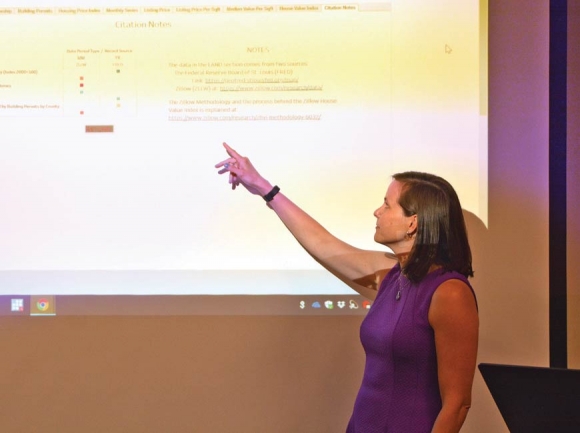WCU unveils new economic tool
 WCU’s Dr. Angela Dills unveils the N.C. Data Dashboard at a meeting of the Mountain West Partnership June 6. Cory Vaillancourt photo
WCU’s Dr. Angela Dills unveils the N.C. Data Dashboard at a meeting of the Mountain West Partnership June 6. Cory Vaillancourt photo
A new tool that compiles a mind-boggling array of economic and demographic data and presents it in a simple map-based interface will give economic developers, public servants and private citizens the tools to make more informed policy decisions across the region and the state.
“Say you’ve got an RFP (request for proposals) through a particular lead source, like the Economic Development Partnership or Duke Energy,” said Rich Price, Jackson County’s economic development director. “A lot of those proposals are requests for information that really drill down into specific demographic or land-based data. If you’re a one man show as an economic developer, you don’t always have that information readily available.”
For Price and other economic development professionals, those days may be drawing to a close with the introduction of Western Carolina University’s North Carolina Data Dashboard.
Price also chairs the Mountain West Partnership, a nonprofit that consists of economic developers from the seven rural western counties in North Carolina along with the Eastern Band of Cherokee Indians, the Southwestern Commission and the N.C. Economic Development Partnership.
It was at a Mountain West meeting June 6 where Dr. Angela Dills, the Gimelstob-Landry distinguished professor of regional economic development at WCU unveiled the tool, which is available at www.ncdatadashboard.org.
“The professorship was started to help by policymakers make better decisions and I think providing people in the region with what’s happened in the past and what’s happening now is a great way to help them make better decisions,” said Dills.
Related Items
“There are multiple places that you have to go to find the data that was presented here today,” Price said. “Having it in one spot we, can get those answers quickly, and this information is presented in a fashion it will be beneficial in terms of making a strong pitch for business development purposes. I think it’s and incredible resource.”
As one of the developers of the Data Dashboard, Dills said that the website can display more than 12,000 sets of unique data from places like the Bureau of Economic Analysis and the Federal Reserve’s Economic Database.
“I’m basically an applied micro-economist but most of my research is in policy analysis, so I do a lot of work on health and education policy, which are my particular interests,” Dills said. “I typically describe myself as a data geek. I like data. I like what I think it can show us about what’s happened in the past, what’s working well and what’s working less well.”
Providing meaningful data that decision makers can use to take action, Dills said, is not only a personal interest but also central to her professorship and the main reason the Dashboard was created as a collaborative effort.
“We kind of relied on a wide variety of people at the university to help us,” Dills said. “There are people in marketing who are helping with website design, or people that are in IT who have helped with a lot of back end and Sequel server.”
This finished product is divided into five sections, which are further subdivided into some fairly granular metrics that can all be sorted out by year, by county and by region.
The section focusing on land shows stats like home ownership rate, number of building permits issued and listing price per square foot, while the labor section shows not only relatively pedestrian stats like unemployment, but also charts extensive compensation data by NAICS industry code. The product section details industry and compensation data, and the demographics section includes educational attainment levels as well as credit score data. The final section, industry, delves deeply into county-level GDP figures — a stat rarely seen.
There is so much information out there that’s accessible to the average person and huge agencies are getting better and better at collecting data,” said Tom Tveidt of Syneva Economics. “There’s a lot of money that goes into this data. But the missing pieces getting it out the door, that’s where something like this is really valued.”
Syneva provides similar statistics by contract to all sorts of entities, including chambers of commerce and municipalities; Tveidt currently does so for the Haywood County Chamber of Commerce.
“My thing with the chamber is on the economic development side, but this is the kind of information that anybody, any organization or private citizen could use which I think is fabulous,” said Tveidt.
According to Tveidt, such “dashboards” aren’t uncommon across academia, because producing such a time-intensive project is beyond the reach of most private businesses.
“There’s a void, and they’re the people that can fill that. They [academia] should be the ones to fill that role, if it’s not going to be the state or local agencies,” he said.
But the real challenge, he said, is keeping a dashboard like WCU’s up-to-date.
“Those numbers are changing, and they don’t all change together. Each one of them is changing independently and you’ve got understand that data and readjust it, and so there’s a lot of behind-the-curtain work,” said Tveidt. “You have to understand the data, who’s putting it together, when it’s coming out, and that just takes a tremendous commitment of time, really.”
Dills said they’ve taken steps to ensure the ongoing operations of the dashboard, which took 10 months to create with the help of WCU students.
“We’re still trying to figure out what sustainability looks like going forward,” she said. “The Center for the Study of Free Enterprise has several years of funding committed to it, my professorship has ongoing funding as well as an endowment.”
Ensuring funding is one thing, but reducing operating costs is just as important. Right now, all data must be collected by hand from primary sources, although Dills said it’s really more of a “copy/paste” situation than legions of students entering numbers into spreadsheets one by one.
“What students are working out now is automating a lot of the website, doing things like handling the data that’s coming from public websites. There are ways to program that so that the software is going to go poll the website and the database and manipulate it,” she said. “So there’s some automation that can happen on our end to keep ongoing costs lower. And it gives the students great experience.”
Dills stressed that although the data dashboard is already a robust tool, it’s still just the beginning of a more data-driven approach to regional decision-making.
“We look forward to building it out, and finding new and better ways to serve the community.”









